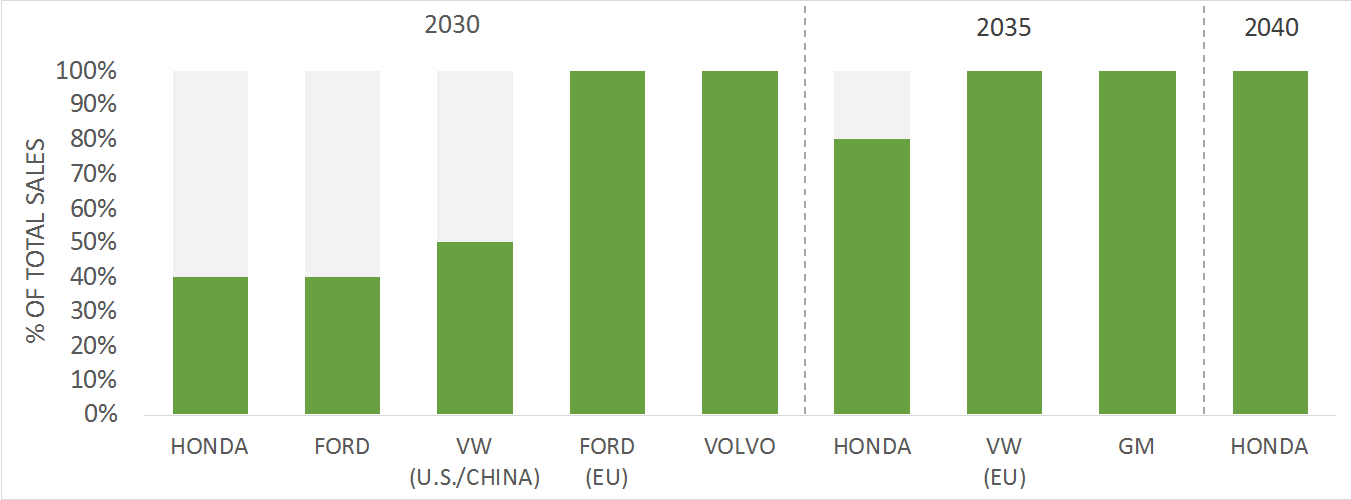As millions of Americans hit the road this weekend to visit loved ones and celebrate the Fourth of July, there is increasing reason for optimism that our road trips of the future will be in vehicles that do not emit any pollution.
This past week, the Environmental Protection Agency sent proposed motor vehicle emissions standards to the Office of Management and Budget for review. The proposed action will include strengthened pollution standards for new passenger vehicles through model year 2026, which will reduce climate and health-harming pollution and help correct the prior administration’s rollbacks to our nation’s clean car standards.
EPA’s proposed standards will be an important, near-term step forward.
But the Biden administration has an even bigger opportunity in front of it – to clearly articulate a bold, long-term vision to eliminate tailpipe pollution from new motor vehicles, one that ensures at least 60% of new passenger cars and trucks sold in the U.S. by 2030 are zero-emitting and that all new vehicles sold by 2035 are zero-emitting.
Realizing this vision would have enormous benefits for Americans’ health, the climate, and our pocketbooks:
- It would prevent as many as 98,000 premature deaths by 2050 by significantly reducing the ozone-forming pollution and harmful particulate pollution that disproportionately burdens people of color.
- It would reduce a total of more than 11.5 billion metric tons of carbon pollution by 2050. That’s far more than the carbon emissions from China last year, and China is responsible for more than a quarter of the world’s climate pollution.
- It would save a person who purchases a new battery electric vehicle in 2027 $5,300 over the vehicle’s lifetime compared to a gasoline vehicle.
- It would provide more than $1.6 trillion in benefits to Americans, including pollution reductions and economic savings. That is about 10% of current U.S. gross domestic product.
EDF has done extensive analyses of these benefits both for passenger vehicles and for medium and heavy-duty trucks and buses. We found this is an ambitious commitment that will deliver enormous benefits. It is also firmly rooted in the actions of states and countries around the world and the commitments and investments automakers are announcing on an almost daily basis.
For instance, in early May the California Air Resources Board hosted a public workshop on the development of its Advanced Clean Cars II program, where it announced that it intends to propose multipollutant standards that will ensure all new cars and light-duty trucks sold in California are zero-emitting vehicles by 2035. Massachusetts has already indicated it will adopt these standards, and a bipartisan coalition of Governors has also called on President Biden to accelerate deployment of zero-emission vehicles through strong pollution standards that match this state ambition.
Countries around the world have also been leading. Earlier this week, Canada announced that it will aim to eliminate tailpipe pollution from new motor vehicles by 2035 (accelerating its prior 2040 commitment). The EU will release strengthened vehicle standards in mid-July, which recent reporting has also suggested will aim to eliminate new motor vehicle tailpipe pollution by 2035.
Automakers have also made ambitious commitments. GM recently announced its aspiration to eliminate tailpipe emissions from new light-duty vehicles by 2035. Ford has projected that 40 percent of its global sales and 100 percent of its European sales will be zero-emitting by 2030. Volkswagen had previously announced that it expects 50% of its U.S. sales to be electric by 2030, and in the last several weeks has indicated it plans to further accelerate electric vehicle production and sales in the U.S.
These commitments have been backed by investments that are creating jobs. Ford and GM have committed to spending $65 billion on vehicle electrification through 2025. These and other manufacturer investments are helping to support jobs in communities across the country, including Michigan, Ohio, Texas, Tennessee and Georgia. EDF has captured these state and country actions, manufacturer commitments, and investments in a new fact sheet.
It is critically important that the Biden administration seize this momentum and announce a vision to eliminate pollution by 2035 and to ensure that at least 60% of new vehicles sold by 2030 are zero-emitting.
Doing so will help to support EPA’s development of long-term, multipollutant standards which will be necessary to achieve our climate goals and reduce the harmful pollution that disproportionately burdens low-income communities and communities of color. It will help to demonstrate U.S. leadership in meeting our international climate commitments, which is especially important as representatives from countries around the world converge in Glasgow this fall. It will also make clear to automakers that the U.S. is prepared to lead, which will unlock investments that can help ensure American workers are building the zero-emitting vehicles of the future.
As we celebrate Independence Day this year, we urge the Biden administration to clearly declare that the U.S. is committed to a future free from the harms of motor vehicle air pollution – a future that is healthier, more equitable and more prosperous.












One Comment
This Fourth of July, we have an opportunity for independence from harmful .It enabled the provision of energy services to become site-independent. We have an opportunity to set world- … But vehicles are not the only source of harmful .